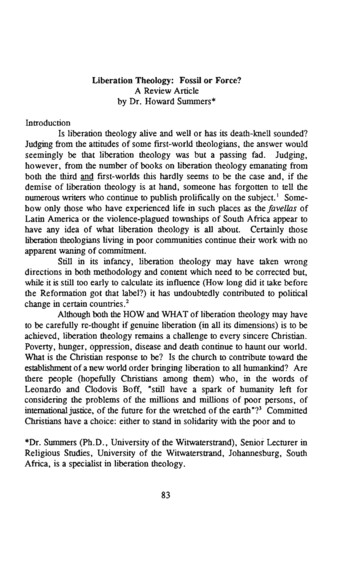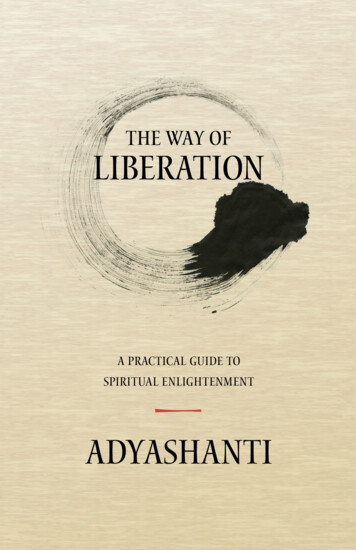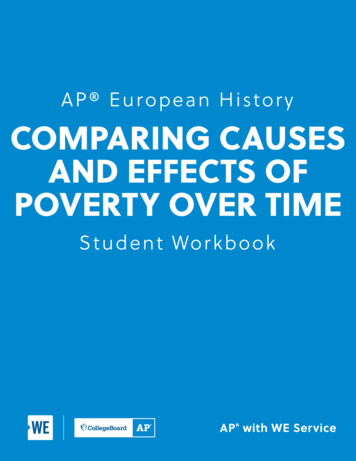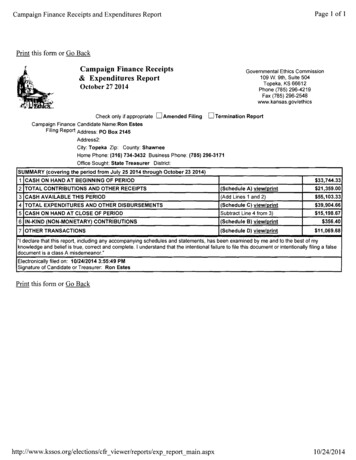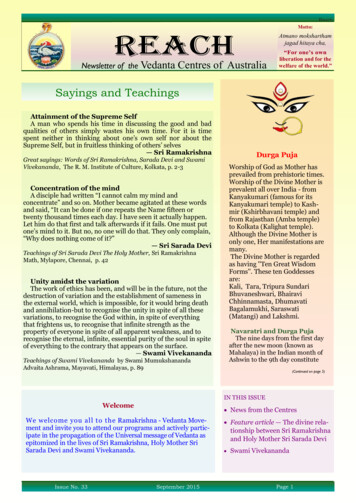
Transcription
ReachMotto:Atmano moksharthamjagad hitaya cha,Newsletter of the VedantaCentres of Australialiberation and for thewelfare of the world.”Sayings and TeachingsAttainment of the Supreme SelfA man who spends his time in discussing the good and badqualities of others simply wastes his own time. For it is timespent neither in thinking about one’s own self nor about theSupreme Self, but in fruitless thinking of others’ selves— Sri RamakrishnaGreat sayings: Words of Sri Ramakrishna, Sarada Devi and SwamiVivekananda, The R. M. Institute of Culture, Kolkata, p. 2-3Concentration of the mindA disciple had written “I cannot calm my mind andconcentrate” and so on. Mother became agitated at these wordsand said, “It can be done if one repeats the Name fifteen ortwenty thousand times each day. I have seen it actually happen.Let him do that first and talk afterwards if it fails. One must putone’s mind to it. But no, no one will do that. They only complain,“Why does nothing come of it?”— Sri Sarada DeviTeachings of Sri Sarada Devi The Holy Mother, Sri RamakrishnaMath, Mylapore, Chennai, p. 42Unity amidst the variationThe work of ethics has been, and will be in the future, not thedestruction of variation and the establishment of sameness inthe external world, which is impossible, for it would bring deathand annihilation-but to recognise the unity in spite of all thesevariations, to recognise the God within, in spite of everythingthat frightens us, to recognise that infinite strength as theproperty of everyone in spite of all apparent weakness, and torecognise the eternal, infinite, essential purity of the soul in spiteof everything to the contrary that appears on the surface.— Swami VivekanandaTeachings of Swami Vivekananda by Swami MumukshanandaAdvaita Ashrama, Mayavati, Himalayas, p. 89Durga PujaWorship of God as Mother hasprevailed from prehistoric times.Worship of the Divine Mother isprevalent all over India - fromKanyakumari (famous for itsKanyakumari temple) to Kashmir (Kshirbhavani temple) andfrom Rajasthan (Amba temple)to Kolkata (Kalighat temple).Although the Divine Mother isonly one, Her manifestations aremany.The Divine Mother is regardedas having ''Ten Great WisdomForms''. These ten Goddessesare:Kali, Tara, Tripura SundariBhuvaneshwari, BhairaviChhinnamasta, DhumavatiBagalamukhi, Saraswati(Matangi) and Lakshmi.Navaratri and Durga PujaThe nine days from the first dayafter the new moon (known asMahalaya) in the Indian month ofAshwin to the 9th day constitute(Continued on page 5)IN THIS ISSUEWelcome News from the CentresWe welcome you all t o the Ramakrishna - Vedanta Movement and invite you to attend our programs and actively participate in the propagation of the Universal message of Vedanta asepitomized in the lives of Sri Ramakrishna, Holy Mother SriSarada Devi and Swami Vivekananda.Issue No. 33September 2015 Feature article — The divine relationship between Sri Ramakrishnaand Holy Mother Sri Sarada Devi Swami VivekanandaPage 1
ReachNews from the CentresMay to August 2015Adelaideemail: vedanta.adelaide@gmail.comContact: Dr Raman Sharma – (08) 8431 9775Mrs Pathma Iswaran – (08) 8379 5336Regular Activities:a) Swami Sridharanandaji visited Adelaide from April2-4, May 7-9, June 11-13 and July 23-25 and continued with his discourses on the SrimadBhagavad Gitā at the Dulwich Community Centre,14 Union Street, Dulwich SA 5065. A dedicatedgroup of devotees attended his talks, which havebeen recorded.b) Every month on a prescheduled Sunday readings from The Gospel of Sri Ramakrishna, including discussion on relevant points, were conductedat devotees’ homes.Other Activities:a) The Annual Celebration of the Adelaide Chapterwas held on Saturday May 9 at the Dulwich Community Centre from 9:00 a.m.—1:00 p.m. A groupof devotees sang bhajans while Swami Sunishthananda performed the traditional worship.Swami Sunishthananda also spoke on The Life andTeachings of Sri Ramakrishna. Swami Sridharananda was also present. Many devotees par-Auckland27 Arawa Street, New Lynn, Aucklandhttp://www.rkvc.org.nz/ticipated in the function and later enjoyed the prasada.b) The Annual General Meeting of the Vedanta Centres of Sydney-Adelaide Chapter was held on Saturday July 25 from 1:00 p.m in the Coopers Room,Burnside Community Centre, 401 GreenhillRoad, Tusmore SA 5065.c) On the last Sunday of every month readings anddiscussions on the Bhagavad Gitā, The Gospel of SriRamakrishna and the life and teachings of HolyMother Sri Sarada Devi were conducted. The program started at 11:00 a.m. and concluded at 1:00p.m. with Prasad distribution.Email: monnay@ihug.co.nzCelebrations:a) Buddha Purnima was celebrated on 4 May 2015.The program started at 8:00 p.m. with bhajans,after arati. Devotees talked on the life and teachingsActivities:of Bhagavan Buddha. The program concluded at9:00 p.m. with prasad distribution.a) Vesper service was held daily from 7:00 p.m. tob) Guru Purnima was celebrated on 31 July 2015.8:00 p.m. in the Centre. It included the singing ofThe program began at 8:00 p.m. after evening arahymns and readings from The Life of Swami Viveti. The Program started with bhajans and includedkananda followed by meditation.a talk on Sri Ramakrishna as Guru and a talk on theb) On the second Sunday of every month satsang proparallels between Lord Dakshinamoorthy and Srigrammes which include the singing of bhajans, disRamakrishna. The program ended at 9:00 p.m.course on the Ramayana, readings and discussionswith prasad distribution.on the lives of the direct disciples of Sri Ramakrishna, reading and discussion on Complete Works ofUpcoming Celebrations:Swami Vivekananda and meditation were conduct- a) Durga Puja20 October 2015,ed from 11:00 a.m. to 1:00 p.m.b) Christmas Eve24 December 2015Contact: Mr M. KumarIssue No. 33September 2015Page 2
ReachBrisbane12 Greenwood Street, Springfield Lakes, QLD 4300Tel:- 07 3818 9986Email: info@vedantabrisbane.orgContact: Swami AtmeshanandaDaily activities:Worship was conducted daily in the morning.In the evening ārati including bhajans and readingsfrom The Gospel of Sri Ramakrishna were conductedat the Centre.Regular Activities:The Centre conducted the following programmes:a) Yoga Classes on Sunday mornings byDr.Unnikrishnan Pillai.b) Srimad-Bhagavad Gitā classes on Sundays.c) 'Bala Sangha' - moral and spiritual classes for children on Sundaysd) Religious Instruction classes at a school in Brisbane held every Wednesdaye) A satsang was held on the first Saturday of everymonth.f) Discussion groups on the first Monday of everymonth in Sunnybank Hills, Qldg) A class on Ashtavakra Samhita on alternateThursdays at Springfield, Qldh) A class on Meditation and Spiritual Life on alternate Fridaysi) A class on Viveka Chudamani at Toowoomba heldmonthlyj) Sri Ramanama Sankirtanam was sung every fortnight on Ekadashi days.k) A Sanskrit class for beginners was conducted onTuesdays.Other activities:a) Swami Atmeshananda visited Townsville from the26th to 28th June 2015 for talks organised by thelocal group. He spoke on three occasions includingone at the University of Central Queensland.b) The centre moved its premises from Chapel Hill toSpringfield Lakes, Qld on the 1st August 2015. Aspecial worship was conducted on the occasionwhich also coincided with Guru Purnima. SwamiSridharanandaji attended the programme andgave a talk.New premises at Springfield Lakesc) A bookstall was organised by the devotees at theIndia fair held at Roma Street, Parklands in Brisbane on the 15th August 2015. Another stall wasorganised on the 29th August 2015 at the Pacificafair at Goodna, Qld (a suburb of Ipswich).Celebrations:a) Buddha Purnima was celebrated at the Centre onSaturday, 9th May. Chanting of hymns from theDhammapada and other Buddhist texts, bhajansand a talk on the significance of the life of LordBuddha were the important aspects of the programme.Annual Day program— guest of honour lighting lampb) The Centre held its Annual programme on Saturday, 20th June 2015. The event consisted of cultural programmes (classical dance, music etc), atalk by Revered Swami Sridharanandaji, a presentation about the Vedanta Centre in SpringfieldLakes by Richard Weingarten and a speech byTarnya Smith, MP and Shadow Minister for Multicultural Affairs. More than 450 persons attendedthe event.Forthcoming programmes: Sri Krishna Janmashtami 5th September 2015 Sri Sri Durga Puja8th October 2015 Christmas Eve24th December 2015Regular activities:The Centre conducted the following programmes:a) Regular monthly talks on the Srimad-BhagavadGitā were conducted by Swami Sridharanandaduring the months of May, June and July. Lectureswill be continued in October once Swamiji returnsfrom the US lecture tour.CanberraRegistered Address:17 Bean Crescent, Mckellar, ACT - 2617Email: jaishankar venkataraman@hotmail.comContact: Jaishankar Venkataraman 0433 59 3860Issue No. 33Forthcoming programmes: The Chapter will hold its AGM in November.September 2015Page 3
ReachMelbourne5-7 Angus Avenue, Ringwood East, VIC 3135email: vedanta.melb@gmail.comContact: Mr Suresh Ravinutala – 0413 040 599The Centre maintains a bookstall with various literature for sale in print, audio, and visual media on theRamakrishna-Vivekananda, Vedanta philosophy andother spiritual topics.Swami Chandrashekharananda conducted the following programmes in Melbourne:a) Classes on the Kathopanishad on Sundaysfrom 9:00 a.m. to 10:00 a.m.b) Meditation sessions on Sundays from 5:30 p.m. to6:30 p.m.c) Srimad-Bhagavad Gitā revision and discussions through video/audio on Tuesdays from 2:30p.m. to 4:00 p.m.Other activities:a) A Spiritual Retreat was held on Saturday 27th ofJune 2015 from 9:15 a.m. to 2:30 p.m. Apart fromchanting, bhajans and group discussions, SwamiSridharananda delivered two talks on the topicDaily activities:“Spiritual Practices in our daily Lives” followed byWorship was held every morning at 7:30 a.m.an interactive question-answer session. ThirtyVesper service was conducted in the evening from 7spiritual seekers attended the Spiritual Retreatp.m. and this included the chanting of hymns, devob) Farewell to Swami Chandrashekharananda: TheMelbourne centre had the privilege of having Swational singing, reading from The Gospel of Sri Ramami Chandrashekharananda as the resident monkkrishna and meditation.for the past almost two years. Swamiji has nowbeen posted to the Vedanta Centre at Portland,Weekly-Monthly Activities:USA and he left Melbourne on 1st July 2015 to BelurThe Centre conducted the following programmes:Math India on his way to USA. The Society hosteda special satsanga on 28th June 2015 to bid hima) Swami Sridharananda continued to deliver monthfarewell. A large number of devotees attended thely discourses on the Bhagavad-Gitā fromevent and Swamiji spoke about the importance ofthe Thursday to the Saturday of a prescheduledSatsanga (prayer meetings) in our spiritual develweek at the Centre. The Thursday and Friday sesopment. Many devotees spoke warmly about Swasions were held from 7:45 to 9 p.m. and the Saturmiji’s contributions to the Society and his spiritualdays sessions were held from 11:00 a.m to 12:15guidance during this period.p.m. The recordings of these discourses are available in audio, video and MP3 formats for purchase.b) Group study through the viewing of the BhagavadForthcoming programmes:Gita lecture series on video were held on Sundaysa) Sri Krishna Janmashthami: 5th September 2015from 3:00 p.m. to 4:00 p.m.b) Christmas Eve:24th December 2015c) Regular satsanga was held on the first Sunday ofevery month and conducted by Swami Chandrashekharananda.Perth51 Golf View Street, Yokine, WA 6060Email: vedantaperth@gmail.comContact:Hiren Mukhopadyay Secretary0411 478 244Parthiv ParekhAsst. Secretary 0430 511 699Regular Activities:a) Discourses on the Srimad-Bhagavad Gitā wereheld on 1st—2nd May, 4th—6th June and 9th—11thJuly at the Centreb) Monthly satsangas including Dhyanam and readings from The Gospel of Sri Ramakrishna wereheld at the Centre followed by prasad distribution.c) Revision Classes of the Srimad-Bhagavad Gitā talkwas held on 16th JulyDaily activities:A vesper service is held daily at 7:00 p.m. to 8:00 p.m. Forthcoming programmes:at the Centre. It includes arati, readings from The Gos- Sunday satsang will be held on 6th September 2015pel of Sri Ramakrishna followed by meditationIssue No. 33September 2015Page 4
ReachSydney2 Stewart Street, Ermington, NSW 2115www.vedantaaustralia.org/Tel:-02 8197 7351Email: vedasydney@gmail.comThe Centre maintains a bookstall which has a range ofbooks on the Ramakrishna-Vivekananda, Vedanta,Yoga and other spiritual literature. Devotional songs,discourses on the Bhagavad Gitā, the Yoga Sutras ofPatanjali, Mundaka Upanisad, and other topics arealso available in various media.The centre’s library is available to devotees for reference and research.Daily activities: Worship and meditation were held every morningfrom 6:45 a.m. to 7:30 a.m. Vesper service was conducted in the evening from7 p.m. and included devotional singing, readingfrom The Gospel of Sri Ramakrishna and meditation. Counselling, interviews and discussions with devotees were conducted on a daily basis.Regular Activities:The Centre conducted the following programmes:a) Swami Sridharananda conducted classes on theBhagavad-Gitā every Sunday morning from 10a.m. to 11 a.m. at the Centre.b) Parlour talks were conducted by Swami Sridharananda at 1/11 Boyle Street, Balgowlah, NSW2093 Manly Beach on Tuesdays from 7:30 p.m. to8:30 p.m.c) Some devotees availed themselves of spiritualcounselling and guidance. The Swamis also visitedthe homes of devotees when required.d) Katha Upanisad classes were conducted onWednesdays after evening ārati by Swami Sunishthananda.e) Meditation sessions conducted by Swami Sunishthananda were held at the Centre on Sundaysfrom 5 p.m. to 6.15 p.m.f) Bala Sangha Classes on moral and spiritual lessonsand drama and movement were conducted forchildren every Saturday from 4:45 p.m. to 6:45p.m. at the Centre during the academic term.g) Sri Rāmanāma was sung on Ekadashi days afterthe vesper service.h) A class on Meditation and Scriptural Studies forladies was held every Monday from 10:30 a.m. to12:30 p.m. by Swami Sunishthananda.i) The meetings of the Vivekananda Study Circlewere held on Saturdays from 5:00 p.m. to 6.00p.m.j) A session on Yoga Exercise continued to be heldon Saturdays from 9:30 a.m. to 11:30 a.m.Other activities:a) A Spiritual Retreat was held on Saturday 4th ofJuly 2015 from 8.30 a.m. to 5 p.m. Apart fromchanting, bhajans, reading inspiring texts and following these with discussions, Swami Sridharananda delivered two talks on the topics “TheAttainment of Real Freedom and Happiness” and“How Illumined Souls Live in the World” followedby an interactive question-answer session. Fortyfive delegates attended the Spiritual RetreatCelebrations:a) On Saturday, 31st of July 2015, Guru Purnimawas celebrated in the evening. The programmestarted with special worship after the eveningaratrikam followed by rendering of bhajans by Ms.Chirasmita Chakraborty, a talk on the topic‘Significance of Guru Purnima’ delivered by SwamiSunishthananda and a Skit by the children of theBala Sangha. About two hundred and fifty peopleattended the celebration.Forthcoming programmes: Sri Krishna Janmashthami: , 5th September 2015 Durga Puja:Wednesday, 21st October 2015 Annual Day :Saturday, 7th November 2015 Christmas Eve: Thursday, 24th December 2015transfiguration. It is no longer aclay image but the living Goddess,radiating power, knowledge, loveand joy, the benign Mother of theUniverse who has come to bless Herchildren and to assure them of Herlove, help and protection.(Continued from page 1)the festival of Navaratri which isobserved all over India. During thisperiod, the Divine Mother is worshipped in some form or other. Thetenth day is known as Dassera. Inthe northern parts of India, on thisday the life of Rama (known asRamlila) is enacted in public. Inmany parts of India, on this dayweapons, implements, instruments,etc are worshipped.The most striking aspect of DurgaPuja is the image of the DivineMother as Mahishasura-mardini.Here the Divine Mother is seen asIssue No. 33Navaratri 2015 dates are from October 13 to October 22, 2015 .Sourcehttp://www.belurmath.org/durgahaving ten arms, each wielding aweapon. [Hence She is described as puja/article on durga puja.htmDasha-prahara-dharini.] Once theimage is consecrated, and the Deityis invoked in it, it undergoes aSeptember 2015Page 5
ReachFeature articleThe divine relationship betweenSri Ramakrishna and Sri Sarada DeviIntroductionWhen Sri Sarada Devi, the HolyMother came to Dakshineswar, onthe instruction of Sri Ramakrishna,her life of sadhana improved steadily and she became absorbed in it.Holy Mother has narrated her feelings at that time:How the days passed. In themoonlit night, looking at themoon with folded hands, I wouldpray, ‘Make my mind pure likeyour cooling grace!’ When themoon appeared in the sky atnight, seeing the reflection of themoon in the water of the Ganges,I would pray to the Lord withtearful eyes, ‘There is a littleblemish even in the moon. But letthere not be anything in mymind.’Holy Mother’s mantrasSri Ramakrishna instructed Mother about the mantras of many Godsand Goddesses whom he had worshipped in his life and Mother hadpractised all these mantras in herown life. Sri Ramakrishna had madeMother conversant with the intricacies of spiritual life in various ways.He had drawn on paper the kulakundalini and the six chakras andhad given it to Mother. The amountof ‘japa’ and ‘purashcharana’ (takinga vow to repeat the mantra a certainnumber of times for a fixed period)Mother had done is shown from thelakhs of ‘japas’ she had performedwithout completing which she wouldnot take anything in the morning forbreakfast. Even in the later days ofher life, she was very particular inperforming japa and meditation daily. Even during her sickness, Motherwould get up very early in the morning and finish her morning ablutionsin the open field. After that, seatedon the bed itself, with legs stretchedand a blanket on her, she wouldbegin performing japa.Mother had a tulasi mala and arudraksha mala for japa. Usually shewould perform japa once early in themorning during Brahma-Muhurta,the next at the time of puja, the thirdduring the afternoon and the finalone at night. This had become herIssue No. 33Sri Ramakrishna - Sri Sarada Deviregular habit and she rarely skippedit. One evening, when she starteddoing japa while she was not well, anattendant told her, “Mother, this isnot good for you. What is the necessity for you to practise? You haveachieved everything. Why are youtaxing your body unnecessarily?” Atthis Mother replied, “My dear child,what are my disciples doing? Whether they perform their japa or not, Ido not know. For their sake, I dosomething.” On another day anotherattendant told her, “Mother, you donot sleep at night. Whenever I comeout of my room, you ask, ‘Who is it?’From this we understand you don’thave a good sleep at night.” To this,Mother would say, “My child, howcan I sleep? Many have taken dikshafrom me. They are not able to do anything. All my time is spent in doingsomething for them.”Bhava and SamadhiWhen Mother first came toDakshineswar, she did not know anything about bhava and Samadhi.Hence, whenever she saw Sri Ramakrishna in Samadhi or bhava, shewould become frightened. She toohad to pass all these stages and finally had the experience of ‘Nirvikalpa’Samadhi. Yogen-Ma, the longstanding companion of the HolyMother told us, “ I came to the Nahabat I opened the door a little andsaw the Mother laughing heartily.Now she was laughing and a littleafter she was weeping. Tears wereSeptember 2015flowing continuously from her eyes.After some time, she became calmand steady- she was in Samadhi.”“Somebody was playing the fluteone night. Mother entered into bhava on hearing the flute recital-shewas laughing continuously.”“In Nilambar Babu’s house in Belur, one evening, Mother, Golap-Ma,and I were seated side by side on theterrace meditating. When my meditation was over, I saw that the Mother was completely absorbed withoutany movement-no breathing evenshe was in Samadhi. When she cameto consciousness at long last, shesaid, ‘Oh Yogen! Where are myhands? Where are my feet?’ Wepressed Mother’s hands and feet andshowed her Even then she couldnot feel her body and got back hersenses only after a long time.”At Dakshineswar, somebodywould play the flute at night. “TheLord himself is playing on the flute.”Thinking thus Mother would go intosamadhi simply upon hearing thesound of the flute. That was bhavasamadhi or savikalpa samadhi. Thesamadhi, which occurred on the terrace of the house at Belur, was thestate of Nirvikalpa samadhi. Thiscould be understood as such fromthe words of Mother after she cameout of it.Some of Mother’s statementsregarding sadhanaMother’s teachings regarding sadPage 6
hana and its results are encompassed in the following selected incidents:“Only by long practice of austerities, the mind becomes pure.Without sadhana we can never attain the Lord. If you realize God,will you get a pair of horns on yourhead? No! The mind becomes pureand as a result there is an awakening of the consciousness.”“Narendra used to tell me,‘Mother, nowadays, everything isvanishing form my mind. I findeverything is flying.’ I replied, ‘Seemy child, do not allow your mindto efface me.’ Narendra replied,‘Mother, if you fly away from mymind, what will remain? He whoforgets the feet of his guru whenenough, he suffered from poor digestion, and the prasāda of Kali did notsuit him. There was cooking for thedevotees too. Latu was there. TheMaster said, “He is a fine boy. Hewill knead the dough for you.” Therewas no end to cooking, night or day.Ram Datta, for instance, came thereand called out as soon as he alightedfrom the carriage, “I shall take todaygram soup and chapāti.” No soonerhad I heard this, than I started cooking here. There used to be chapātismade out of six to eight pounds offlour. Rakhal stayed here (with theMaster); very often khichudi wascooked for him. Surendra Mitra usedto pay ten rupees every month forthe expenses of the devotees. SeniorGopal used to get things from theReachfloor of the Nahabat and cooked below the staircase. She was too shy tocome out during the day. Yogin-mathus described the Mother’s dailyroutine at the Nahabat: ‘Finishingher bath before four o’clock in themorning the Holy Mother sat formeditation; for the Master used toinsist on meditation. Then she commenced her worship after finishingher other duties. The worship, japaand meditation would take about anhour and a half. Then she sat forcooking under the staircase. Whenthe cooking was over, if she got theopportunity, she would rub oil on theMaster’s body before his bath. TheMaster sat for his dinner betweenhalf past ten and eleven. Wheneverhe went for his bath, the Mother hur-“If you realise God, will you get a pair of horns? No! The mind becomes pureand as a result there is an awakening of the consciousness.”knowledge comes, is still in a stateof ignorance. If the guru’s feet areallowed to vanish, on what willknowledge stand?’” Whenknowledge comes, Iswar and otherconcepts vanish. But Mother encompasses the whole world.“Through japa and meditation,the evil effects of your karma areremoved, but you cannot feel Godwithout ‘prema-bhakti throughjapa and meditation you can control your senses did the cowherdsof Brindavan get Krishna throughprayers and meditation? No! Theywould call Krishna formally, ‘OKrishna, Come, eat and take!’-Theywould address him like this andfinally got him!”The NahabatApart from the few days that theMother lived in the thatched housebuilt by Shambu Babu, she spent therest of her Dakshineswar days in thesmall Nahabat. Those days were extremely uncomfortable days and theMother, too, felt similarly. She said,“When I was at the Nahabat for serving the Master, in what discomfort Ihad to live in that small room, andwhat a lot of things lay huddled together there! Sometimes, I was allalone Golap, Gaur-dasi and othersstayed there now and then. Extremely small though the room was, yet init was carried on cooking, sleeping,eating, - why, everything. Cookingwas done for the Master, for oftenIssue No. 33market. In the beginning my headwould strike frequently against thedoorframe as I entered the room;one day I even suffered a bad cut.But gradually I got used to it, and myhead would bend as I approachedthe door. Women from Calcutta usedto come to visit me, and standing atthe doorway and holding the doorframe on either side with bothhands, they would say, “Alas! Inwhat a room our dear good lady isliving - it’s like living in banishment.” I used to bathe at four in themorning. Whenever there was a littlesunshine on the steps in the afternoon, I used to get my hair sunned.There was only one room on theground floor of the Nahabat, andthat was stacked with goods. Overhead were slings on which was hungpotful of domestic titbits. The worstsource of inconvenience was inadequacy of the facilities for bathing andpersonal cleanliness. Through forcedconfinement I developed physicaltrouble and those fisherwomenwere my companions. When theycame for a bath in the Ganges, theykept their baskets on the verandahand went down for their dip. Theytalked a lot with me and took awaytheir baskets when returning home.At night I heard the fishermen singas they caught fish.”Mother’s daily routine at theNahabatThe Mother lived on the groundriedly prepared betel rolls for him.When he returned, the Motherwould spread a small carpet for himto sit on for his meal, and keep readya glass of drinking water. Then shewould carry to him a plate of food.As he sat for his meal, she wouldconverse on various topics just taking care lest his meal should bespoiled by any upsurge of spiritualemotion. None but the Mother couldprevent such sudden upsurges during meal time.When the Master had finishedeating, Mother would hurriedly takesomething herself and drink a glassof water. Then she would make betelrolls. That over, she would sing in alow tone, and that very cautiously,lest should she be overheard. Thenwhen the mill blew the whistle at oneo’clock, she sat down for her food, sothat her lunch was never finishedbefore half past one or two. Afterfood she would take some nominalrest and then would sit down on thesteps at about three for drying herhair. Then she would turn to trimming the lights and doing other oddbits of work, and then get ready forevening duties after somehow washing her body and clothes with thelittle water she kept in the Nahabat.When evening came, she would lightthe lamps and after waving the censer with the burning incense beforethe deities, sit for meditation. Cooking for the night usually followedthis, and the Mother would have herSeptember 2015Page 7
Reachsupper after all had finished. At lastshe would lie down after a little respite.Once, before dawn, when she wasgetting down the steps for a bath inthe Ganges she almost trod on acrocodile which, taking alarm at theMother’s approach, jumped into theriver. Thenceforth, she never wentfor a bath without a lantern.Numerous inconveniences andhandicaps, heavy duties and troubleswere there; but the Mother neverreally worried about them. Afterwards, when casually alluding to allthese troubles, she would sum upsaying, ‘yet I knew no other suffering no discomfort could touch me ifit was for his (Master’s) service. Theday passed on joyously and quietlyamidst everything’.Living near the great MasterThe Holy Mother, whose life re-Analogy of the parrotsThe Master was not, of course,unmindful of her comforts; on thecontrary he tried to keep her happyin every way. He called that littleroom a cage, surrounded as it was bybamboo chips. Lakshmi Devi, hisniece, too, often stayed there. TheMaster called them, in fun, a pair ofparrots. When Mother Kali’sprasāda was sent from the temple tothe Master’s room, he said to hisnephew Ramlal, ‘Hullo! There is thatpair of parrots in the cage. Carry tothem some gram and fruits.’ Newcomers naturally thought that therewere some real birds; even MasterMahashaya laboured long under thatwrong impression. When LakshmiDevi was not there, the thought ofthe rheumatism and loneliness of theHoly Mother worried the Mastervery much. He said to her, ‘If a wildbird lives in a cage it becomes rheu-warmly attached to the Mother asshe was to him. Gauri-Ma once said,“ Though these two sometimes didnot see each other for six monthstogether, in spite of being only aboutseventy five feet apart, how deep wastheir love indeed for each other.”Once when the Mother had a headache the Master felt extremely anxious and went on asking Ramlal, ‘ORamlal, why does that headachetrouble her?’The Master saw to it that theMother was not needlessly over burdened with work, busy as she wasthe whole day. Once, while on a walkwith Rakhal in the garden of BeniPal of Sinthi, he came across someghosts who implored him to leavethe garden, as the holy atmospherehe diffused around him was toostrong for them to bear. It had beenarranged earlier that he would spendthe night in the garden; but the im-“If but I were one of the devotees over there, I would then be ever so near theMaster, and would hear so many things.”volved round the Master alone, hadseldom even a distant view of him.She said, “Sometimes even during aslong a period as two months, Icouldn’t see him even once. I composed myself by saying, ‘O Mind,what merit have you earned that youwill get his darshan (sight) everyday?’ Standing erect (behind thescreen of plaited bamboo chips, withwhich the veranda of the Nahabatwas surrounded), I used to hear thelines that he sometimes added extempore to the kirtana songs. Thisproduced rheumatism.’Though the Mother was thenphysically separated from the Masterher heart ever hovered around him.The number of devotees visiting th
Ramakrishna-Vivekananda, Vedanta philosophy and other spiritual topics. Daily activities: Worship was held every morning at 7:30 a.m. Vesper service was conducted in the evening from 7 p.m. and this included the chanting of hymns, devo-tional singing, reading from The Gospel of Sri Rama-kr
